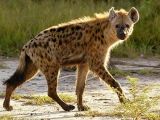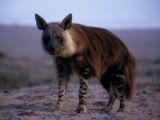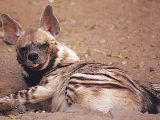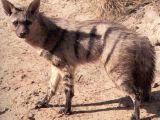1.Hyenas appeared 25 million years ago from ancestors related to the civet cats. Even if the size of civet cats, those early hyenas already had molars for breaking bones. Cave hyena, that inhabited Europe during the Ice Age, was twice the size of the modern spotted hyenas.
2.Spotted hyena is the largest living hyena. It lives from deserts to woodlands in Africa, South of Sahara, except the southernmost areas and Congo basin. The coat has dark spots, and the neck and shoulders present a short and coarse mane. This hyena has rounded ears, the others have pointed ones. Spotted hyenas are up to 1.6 m (5.5 ft) long, 90 cm (3 ft) tall and weigh 50-85 kg (110-200 pounds) - only 4 species of bears and 3 cats, lion, tiger and jaguar, are larger. They live up to 25 years in the wild, and 40 in captivity.
Brown hyena lives from deserts to scrubland and sea shores in western Austral Africa. The long brown hair forms a mantle on the shoulder and back, increasing the apparent size of this animal. The length is up to 1.35 m (4.5 ft), height 88 cm (2.9 ft) and weight 37-50 kg (80-110 pounds). They live about 7 years in the wild, and 13 in captivity.
Stripped hyena lives in open lands and rocky areas in Northern and Eastern Africa, and Middle East to India and southern Central Asia. It lacks in places where there is no shelter on a distance of 10 km (6 mi). Its body has transversal brown stripes. The mane on the middle of the back is made of 20 cm long thick coarse hairs. The animal's length is up to 1.2 m (4 ft), height 85 cm (2.8) ft and weight 25-45 kg (55-100 pounds). They live about 7 years in the wild, and 13 in captivity.
3.Hyenas have the hips below the shoulders, and the back is inclined. Their swaying walk, resembling the trap, is given by the fact that, during their displacement, the hyenas raise simultaneously the two limbs found on the same side, and not the opposed ones.
The hyena paw looks like that of the dogs, with 5 asymmetrical pads, but the trace is different. Fore limbs are larger than hind limbs.
4.Even if they can be seen during the day, hyenas go out for foraging mainly on the evening. The day is spent in the den or around. The den is the widened shelter of another animal or natural grottoes protected by rocks and bushes.
Hyenas are very territorial and the boundaries of the territory are marked using the secretion of anal glands and those placed between the digits. The well-developed anal glands of the brown hyenas produce two distinct smelly secretions: a white viscous one and a black one left on the grasses.
Spotted hyenas live in packs, made of up to 80 individuals, but usually around 15. Unlike in other carnivorous species, the females dominate and are larger than the males.
5.No matter the age and sex, spotted hyenas greet each other through sophisticated ceremonies. Beside "kisses", each animal raises a rear limb so that the other can smell and lick its genitalia. Smell is important in forming and maintaining bonds inside the pack. The connection between the members of the pack is also maintained through sounds, of which some can be heard by the human ear. Each hyena is recognized through its voice, and their howl can be heard several km away. The voice of the spotted hyena sounds like laughs, that's why it is also called 'laughing hyena'.
Brown hyenas hunts alone, but live in larger families of 4-6 individuals with the same family. Brown hyenas greet by raising their mane and mutually smelling each other's head and body. Raised ears and displayed teeth mean dominance in striped hyenas; folded ears denote submissive attitude.
6.The spotted hyena has a very big clitoris, named pseudopenis. It is by far the largest clitoris in the animal kingdom. In these hyenas, the vulva is fused, and the clitoris is used for urination, mating (it contracts for mating and the opening widens to allow the penetration by the male's penis) and giving birth. To complicate it all, the females also possess a fake scrotum made by the enlarged joined vulva and pseudo-testes filled with fatty tissue.
You can imagine the surprise of some of the first explorers in Africa, at the beginning of the XIXth century, when they found that their caged "male" hyenas gave birth! For a long time the species was believed to be hermaphrodite! In fact, only the gland's shape makes the difference between a penis and a clitoris in spotted hyenas. The erection of the penis or clitoris (which is voluntary in both sexes) is certainly a display of submission in both male and female spotted hyena and the clitoris plays a high social role in their clans.
The subordinate individuals lick the clitoris of a higher ranked female as a sign of submission. The clitoris of the dominant female will be licked by all the other females, males (which are inferior to any female) or cubes. When females lick each other's clitorises, this is a greeting or an affective behavior that strengthens links between individuals. Usually, females won't lick males' penises, as they are clearly subordinate, the higher ranked male is inferior to the lower ranked female.
Female spotted hyenas carry in their blood higher levels of testosterone than the males (!), and this even from embryo stage: they are bigger and more aggressive than the males and are the dominant sex in the spotted hyena society.
That's why biologists believed that the clitoris' development was provoked by the huge quantities of testosterone on the fetus. But anti-androgens administration did not stop the growth of the huge clitoris, so now this character is regarded as genetic. As it is impossible to penetrate without the female's cooperation, female spotted hyenas have full control of the mating.
Birth is particularly difficult because the clitoris itself is narrow (although it breaks with the first parturition, thus the subsequent births are easier). Many captive females at first offspring series gave birth to stillborn cubs due to long labor times and in the wild, survival rates of females fall sharply with first giving birth, thus first birth is extremely hazardous for the spotted hyena females.
This evolutionary trade-off is somewhat like that with the human bipedal position and the pelvis bones in human female. But it seems to have paid off, as the spotted hyenas, due to their social organization, are the dominant big predator in the African savanna, much more numerous than lions and leopards. The other hyena species (stripped and brown) do not present the trait of enlarged clitoris.
7.All hyenas feed on carcasses, but the spotted hyenas, with its well developed sight and smell and pack life, is also a skilled hunter. They can hunt solitarily, but in most cases these hyenas go in packs. They can reach 65 km (41 mi) per hour, and can kill zebras and wildebeests (which are three times heavier than the hyenas) after chasing them for over 5 km (3 mi). Victims are grasped by legs or pelvis until they are turned down. When the victim is down, the pack rips it apart. A spotted hyena can eat up to 15 kg (33 pounds) of meat once. During the breeding season of the hoofed mammals, the spotted hyenas screen the savanna looking for calves. In fact, lions often steal the prey of the spotted hyenas.
The hyena jaw is more powerful than those of the lion or tiger: they can break even the thickest bones of the cattle or buffaloes. The anterior molars can generate a pressure of 800 kg. Their feces are white, as only the calcium is left from the digested bones. Spotted hyenas can eat from rhinoceros or impala meat to lion, panther, elephant, buffalo, and even insects, reptiles or some grass. 90 % of their menu is made of animals over 20 kg (44 pounds) which they can bring down alone. Besides carrions, human wastes are consumed too. From the corpse, each hyena tries to tear a large piece of meat and to retreat with it aside, so that the others wouldn't steal it.
Brown hyenas and striped hyenas look for carcasses rather using their kin smell. Sometimes, they associate in pairs, and in this case they can bring down larger preys, like lambs and goats. Their menu is completed with insects, eggs, vegetables and fruits. If the brown hyena encounters a large carrion, it will hide pieces of meat for later consumption. They also eat dead fish and sea animals. Depending on food abundance, brown hyenas can forage up to 10 hours daily. These hyenas do not drink water; their water supply comes from preys and some species of wild melons and cucumbers.
In the past, the dead fallen in tribal fights in Central and Northern Africa were left outside the villages to be eaten by hyenas.
8.Most brown hyenas give birth between August and January. In the case of spotted hyenas, the pack members mate between them, on brown hyenas vagrant males mate with the females that accept their advances while passing through their territories.
Gestation lasts 110 days in the case of the spotted hyena, 90 days for the other hyenas. In the case of spotted hyenas, females give birth in a common den to two offspring. Unlike in the case of other predators, the newborn spotted hyenas have opened eyes, teeth and can run in case of danger. The offspring are cared in the den by one to several females and suckled outside the den. Pups are carried with the jaws. The first 8 months of life are spent under the protection of the den. After that, they follow their mothers in the hunt, as mothers do not bring food to the den, so that the smell of meet wouldn't attract other predators. Spots emerge at the age of 4 months and the cubs are weaned by the age of 12-18 days.
Brown hyenas have two young, stripped hyenas up to 5. In these species, the newborn are blind and helpless. The eyes open in two weeks. In brown hyenas, beside the mother, other females suckle the cubs as well, and three months later the whole family bring food for the young to the den. The young are weaned at 12 months old, but remain with the family for another months.
9.In hot days, hyenas can wade, and even if they look blowzy, they clean themselves by licking their coat using their rough tongue.
10.All hyenas species are easy to tame, if competence and professionalism are used.
11.Unlike dogs and wolves, hyenas howl with the head downward.
12.In some parts of India, hyena tongue is considered a delicacy and anti-cancer properties are attributed to it.
13.In the hyena family, there is a fourth species, called aardwolf. It looks like a stripped hyena, but it is much smaller (maximum 14 kg or 30 pounds). It feeds on termites, caught with the sticky tongue, but also mammals, birds, and other insects.
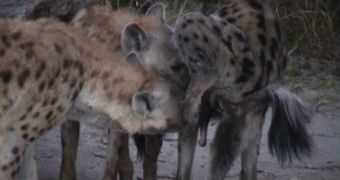
 14 DAY TRIAL //
14 DAY TRIAL // 
